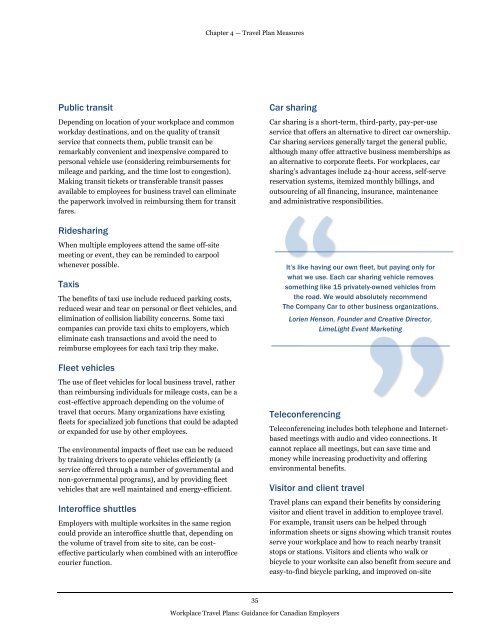Workplace Travel Plans - main body - Final Jan 2010 ENGLISH - FCM
Workplace Travel Plans - main body - Final Jan 2010 ENGLISH - FCM
Workplace Travel Plans - main body - Final Jan 2010 ENGLISH - FCM
You also want an ePaper? Increase the reach of your titles
YUMPU automatically turns print PDFs into web optimized ePapers that Google loves.
Chapter 4 — <strong>Travel</strong> Plan Measures<br />
Public transit<br />
Depending on location of your workplace and common<br />
workday destinations, and on the quality of transit<br />
service that connects them, public transit can be<br />
remarkably convenient and inexpensive compared to<br />
personal vehicle use (considering reimbursements for<br />
mileage and parking, and the time lost to congestion).<br />
Making transit tickets or transferable transit passes<br />
available to employees for business travel can eliminate<br />
the paperwork involved in reimbursing them for transit<br />
fares.<br />
Ridesharing<br />
When multiple employees attend the same off-site<br />
meeting or event, they can be reminded to carpool<br />
whenever possible.<br />
Taxis<br />
The benefits of taxi use include reduced parking costs,<br />
reduced wear and tear on personal or fleet vehicles, and<br />
elimination of collision liability concerns. Some taxi<br />
companies can provide taxi chits to employers, which<br />
eliminate cash transactions and avoid the need to<br />
reimburse employees for each taxi trip they make.<br />
Fleet vehicles<br />
The use of fleet vehicles for local business travel, rather<br />
than reimbursing individuals for mileage costs, can be a<br />
cost-effective approach depending on the volume of<br />
travel that occurs. Many organizations have existing<br />
fleets for specialized job functions that could be adapted<br />
or expanded for use by other employees.<br />
The environmental impacts of fleet use can be reduced<br />
by training drivers to operate vehicles efficiently (a<br />
service offered through a number of governmental and<br />
non-governmental programs), and by providing fleet<br />
vehicles that are well <strong>main</strong>tained and energy-efficient.<br />
Interoffice shuttles<br />
Employers with multiple worksites in the same region<br />
could provide an interoffice shuttle that, depending on<br />
the volume of travel from site to site, can be costeffective<br />
particularly when combined with an interoffice<br />
courier function.<br />
Car sharing<br />
Car sharing is a short-term, third-party, pay-per-use<br />
service that offers an alternative to direct car ownership.<br />
Car sharing services generally target the general public,<br />
although many offer attractive business memberships as<br />
an alternative to corporate fleets. For workplaces, car<br />
sharing’s advantages include 24-hour access, self-serve<br />
reservation systems, itemized monthly billings, and<br />
outsourcing of all financing, insurance, <strong>main</strong>tenance<br />
and administrative responsibilities.<br />
It’s like having our own fleet, but paying only for<br />
what we use. Each car sharing vehicle removes<br />
something like 15 privately-owned vehicles from<br />
the road. We would absolutely recommend<br />
The Company Car to other business organizations.<br />
Lorien Henson, Founder and Creative Director,<br />
LimeLight Event Marketing<br />
Teleconferencing<br />
Teleconferencing includes both telephone and Internetbased<br />
meetings with audio and video connections. It<br />
cannot replace all meetings, but can save time and<br />
money while increasing productivity and offering<br />
environmental benefits.<br />
Visitor and client travel<br />
<strong>Travel</strong> plans can expand their benefits by considering<br />
visitor and client travel in addition to employee travel.<br />
For example, transit users can be helped through<br />
information sheets or signs showing which transit routes<br />
serve your workplace and how to reach nearby transit<br />
stops or stations. Visitors and clients who walk or<br />
bicycle to your worksite can also benefit from secure and<br />
easy-to-find bicycle parking, and improved on-site<br />
35<br />
<strong>Workplace</strong> <strong>Travel</strong> <strong>Plans</strong>: Guidance for Canadian Employers

















